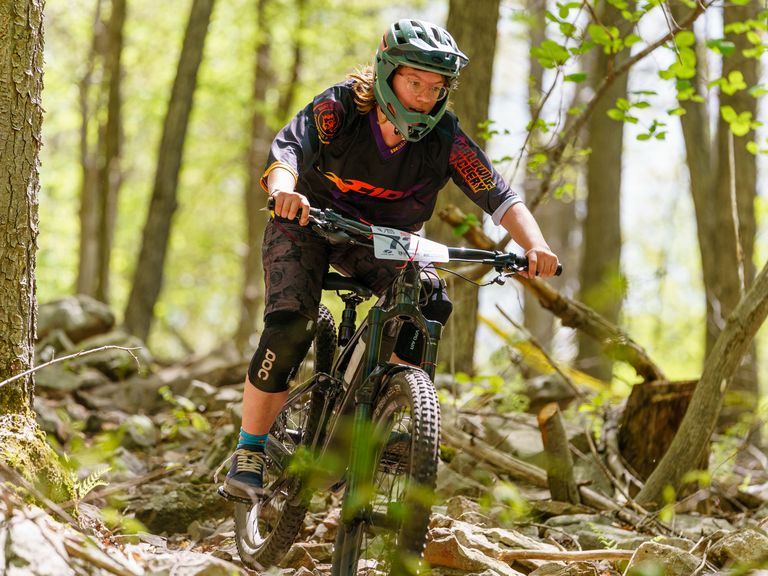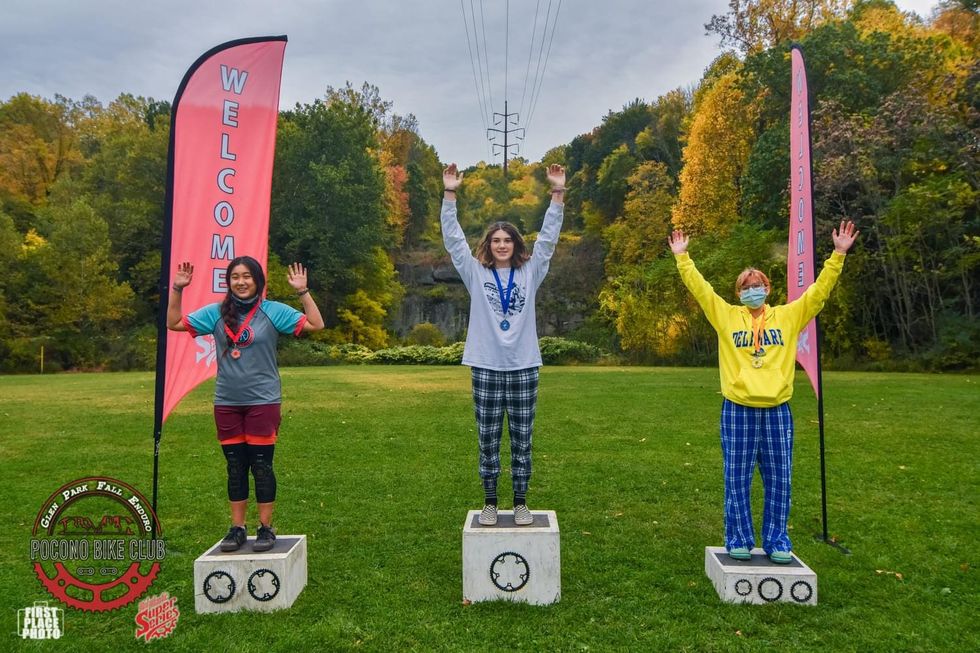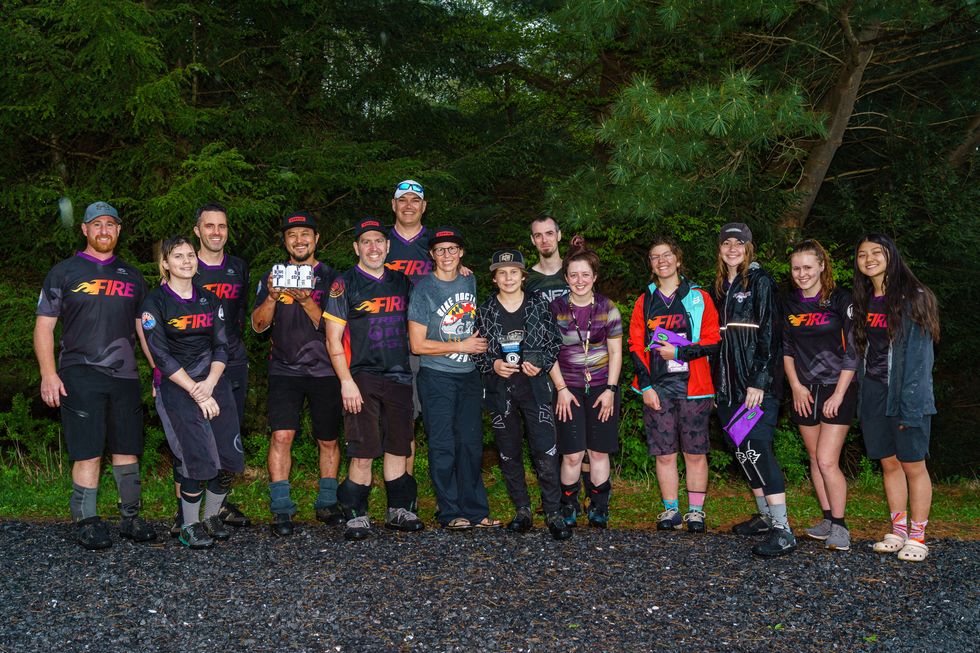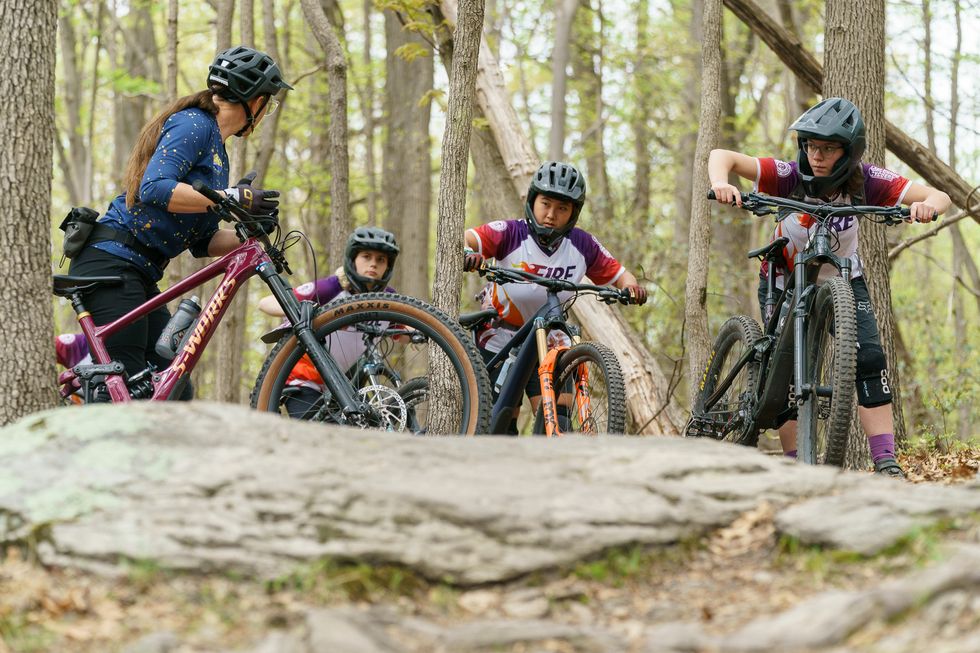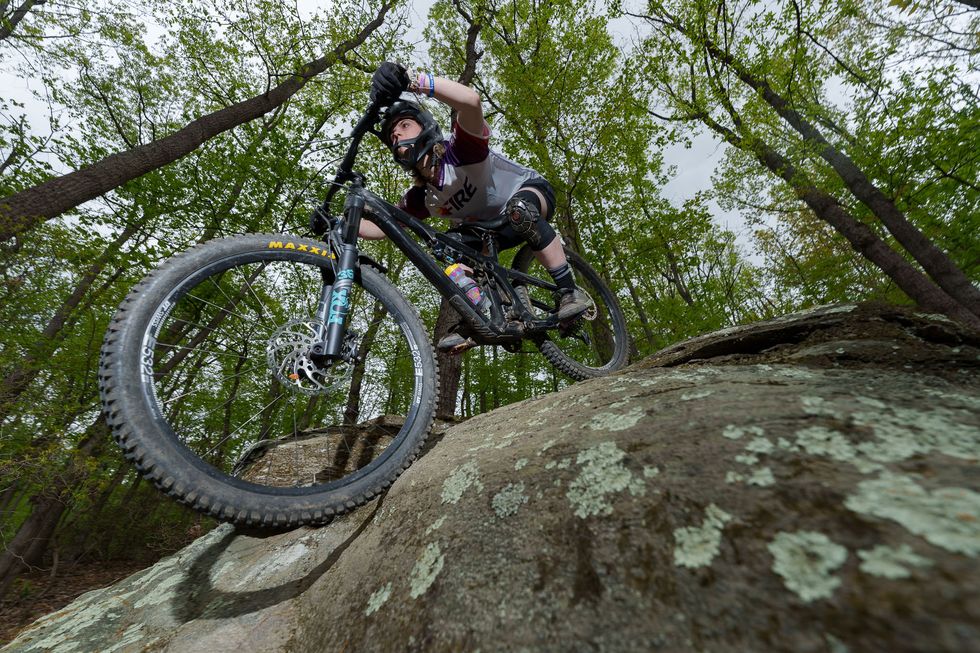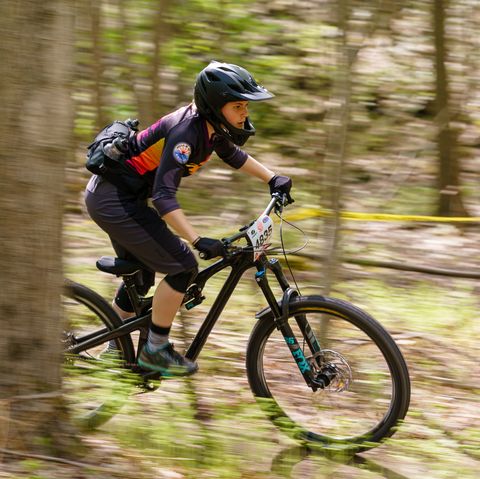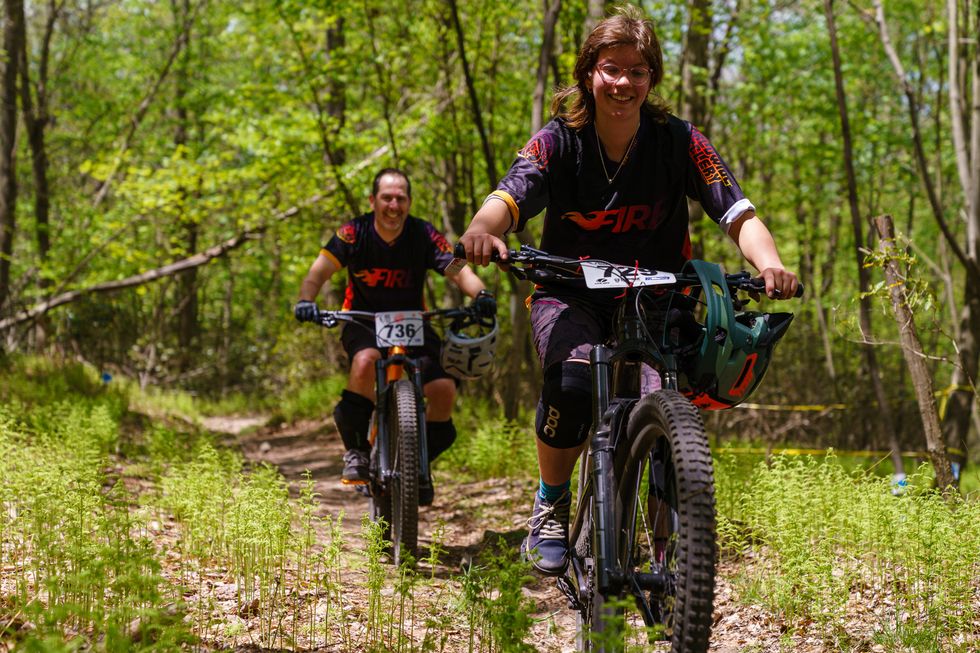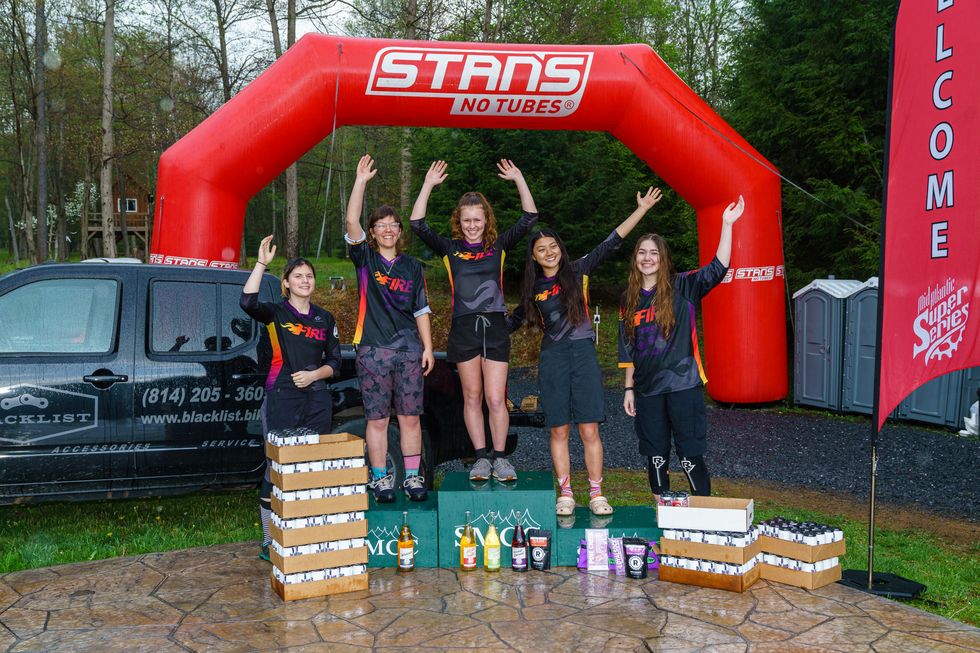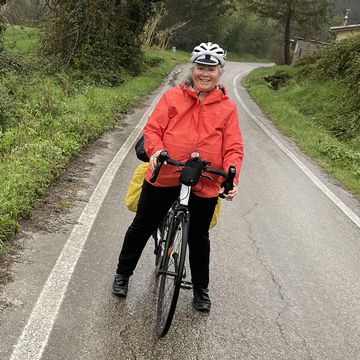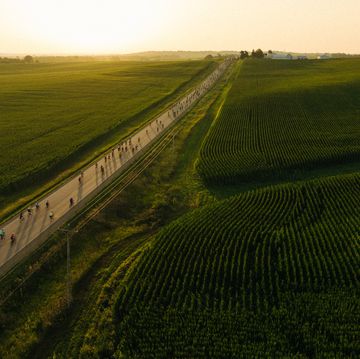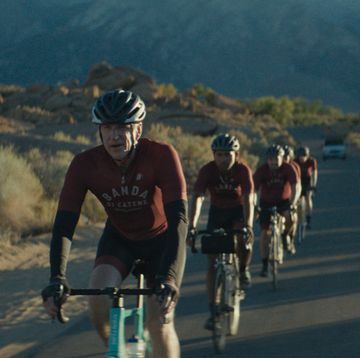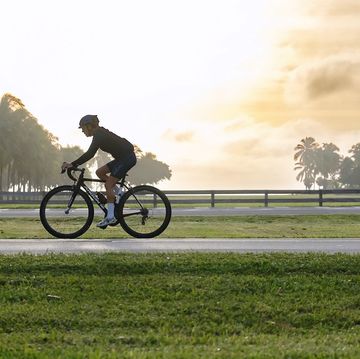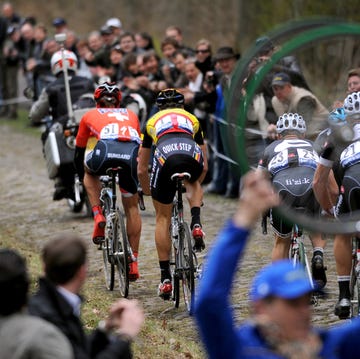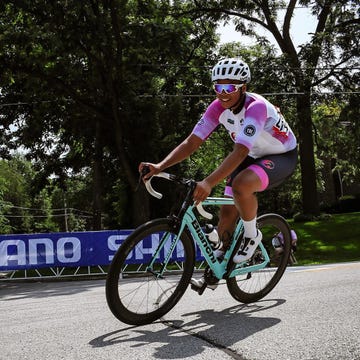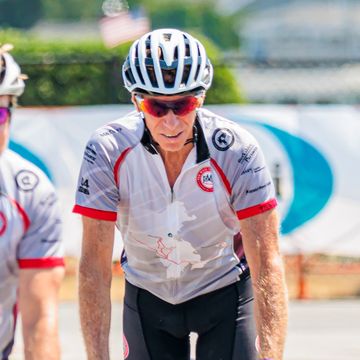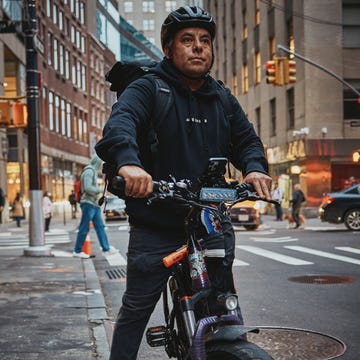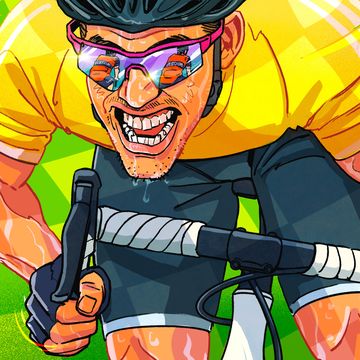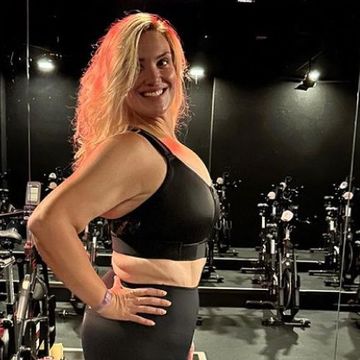Julia Georgopulos and Sarah Howard, both 13 at the time, didn’t know each other prior to their race in 2020. In a field of 121 athletes in Palmerton, Pennsylvania, they were two of very few girls under the age of 19 racing the Blue Mountain MASS Enduro. It was a five-stage race with lift access, and only the downhill segments were timed.
While the girls had fun at Blue, they felt the atmosphere wasn’t exactly welcoming for young ladies. Sarah’s mom, Pascal Howard, and Julia’s mom, Shelly Georgopulos, started a conversation online after the event.
“We were both confused by the registration process. Sarah wound up in Amateur Women and I put Julia in U15 Boys, which made it hard for the girls to connect,” Shelly Georgopulos told Bicycling. “With enduro racing, you spend the day with your category so they weren’t even riding the lifts together.”
After that first race, they started reaching out to some race organizers. The responses varied:
- “Girls don’t race enduro, it’s dangerous.”
- “Enduro racing is a big day on the bike and we don’t want the girls to get hurt or turned away from the sport.”
- “We’ve never had any complaints before.”
- “We’re inclusive – girls can race in whatever category they want.”
With responses like this, Shelly and Pascal knew they’d have to work with their daughters and their friends to make enduro a more welcoming space. As a result, F1RE was born.
F1RE is a collective of families from the Philadelphia area who work to provide a team structure and resources for under-19 riders who identify as female or nonbinary. The young riders race and have fun while the parents work with event organizers and promoters to make the sport more welcoming.
The team has accomplished quite a bit since it began—F1RE now supports over 20 girls/ladies/nonbinary athletes on their race roster with weekly rides, races, and clinics from April to November. For eight riders, 2023 has been their first time racing enduro. Bicycling wanted to ask Georgopulos more about the direction F1RE is going, what they hope to accomplish, and if she has advice for anyone looking to get started.
Bicycling: What does the name F1RE mean?
Shelly Georgopulos: Females 1st Racing Enduro. When Julia and Sarah decided that, yes, they wanted to build a team, they invited a few more girl friends. Together, we took the founding five girls through an exercise to get clear on who we are and what we wanted to stand for and as a result, we came up with a team name, logo, mission and brand. Inclusivity is paramount to the team and we felt it was important to have a statement on gender.
Who is currently on the team and how much help do you have?
The 2023 roster has 12 U19 girls and nonbinary kids, 12 adult women, and 8 dads/dudes. We decided to open the roster to adult women this year, in part because we realized our girls are aging out of U19, but also because the team gets requests from adult women who want to race. That’s in line with our mission—to diversify the sport and encourage those who are underrepresented to feel welcome. The dads/dudes have been willing to serve as sweeps, to shuttle, to basically take a back seat and let the girls and women lead the rides. It’s a different dynamic because it’s not always the fastest person leading a ride and that’s okay! Everyone benefits from seeing girls and women in a leadership position.
In addition to myself and Pascal, Sam Song rounds out our “Leadership Committee.” Anytime we have to make a big decision or when we have sponsorship money to spend, the three of us bounce around ideas. It’s helpful to have different outlooks when it comes to running a team, especially when we’re constantly pressing an entire community to make change. Pascal is analytical, Sam is diplomatic and I tend to make a lot of noise. It helps to have the mix.
We also have additional coaching help. From our very first year, Downhill coach Hillary Marques of HillsMTBSkills sponsored us, and she makes time to work with the girls at a greatly reduced rate. The adults who help run the team are level 3 NICA coaches, but none of us have the skills or credibility that Hillary does.
As the founder, what’s involved behind the scenes?
Since we’re dealing with juniors, we’re pretty formal: insurance coverage allows for a limited number of athletes and a limited number of rides, so we use TeamSnap to track that. We post a schedule of events and people indicate their availability so we can group the riders, provide leaders, and sweeps. Some kids are now using the team for their Alt-PE credits at school which is another reason to have an accurate tracking method.
We get support from our sponsors like Worldwide Cyclery and Dirt Rooster, so we’re able to give rostered riders some gear such as MAXXIS tires and scholarship money for skills clinics based on race participation and financial need. We try really hard to keep the cost of the skills clinics to a minimum and we’re able to do that with help from Hillary and our sponsors.
What kind of experience do riders usually have before joining F1RE or racing enduro?
Any rider, regardless of age or gender, is usually a fairly strong MTB rider and has usually enjoyed some success racing XC before attempting to race enduro. In my experience, the progression is: race and/or coach NICA, compete in a grassroots XC racing series, get a little bored with the XC terrain or the XC race format or maybe just start looking for other ways to progress and become curious about enduro.
Is MTB experience crucial?
With enduro racing, the terrain is more technical and less flowy than cross-country riding, so any athlete needs a certain level of comfort with steep chutes, jumps, drops, and lots and lots of rocks. During an enduro race, you can certainly hop off your bike (or get tossed off) for a small section or take the B-line around a feature, but if you do that on every stage, chances are you’re going to feel like you’re in over your head. Plus, a rider needs the physical endurance to be able to pre-ride the racecourse on a Friday or Saturday and then race it on Sunday. So, yes, I’d say MTB experience is crucial, but I’d also like to reiterate that this is true regardless of gender.
Are there categories for newer folks?
Some of the most successful enduro race events embrace the “new to enduro” rider and offer Enduro Lite or 1st Timer categories, which usually eliminate a tough stage or two and time the racers on the 3 easiest stages. For a kids’ enduro-lite they often send a sweep to accompany the kids because getting from one stage to the next can require some navigation skills. If every race had this, it would encourage more folks to give it a try. This year, Steel City offered a U15 Girls category in lieu of a U15 Coed category and they filled it, which is awesome!
What kind of changes are you wanting to see made, and by whom?
Thanks to lobbying efforts from within the bike community, more races are doing a good job with what I’m suggesting here, but most have room to improve. Some suggestions:
- INFORMATION: Make your information easy to find and respond to questions! Parents are often not super plugged into the enduro community and as the team director, I get the same questions over and over. Parents complain about emails going unanswered or not getting enough detail. That’s one advantage of being on a team: you can ask your team director about the terrain, lodging, start times, extra pre-rides, and things like that instead of relying on an email through BikeReg.
- ON-RAMP: Create an on-ramp to enduro racing so folks can give themselves permission to try a race without expectations. This could be a First Timer Cat or a Kids Cat and it helps to keep the categories consistent across all races within a series. For First Timer cats you could include an info packet, a list of helpful contacts, a couple of early guided rides for newbies only, a discounted rate, a buddy pass, there’s lots of ways to get creative. You cannot open a girls’ category and expect it to fill up without doing the work to build a base.
- REGISTRATION MINIMUMS: When races know they’re going to sell out they can set aside a minimum number of registrations for underrepresented categories. Sheduro does this.
- OUTREACH: Invite the teams and racers you want to attract! If you have teams with a successful XC record, they probably have girls and women who are curious and excited about enduro. Invite them!
- LANGUAGE: Language matters so clean it up. Work to get offensive trail names scrubbed from Trailforks, Strava, and certainly your race materials.
- LEADERSHIP: Look at the decision makers in your organization and the people in positions of power. Do they represent the groups you want to attract? Do they represent the people who aren’t showing up to your races? If you want more women and people of color or LGBTQ+ folks at your events, put them in a position of leadership and listen to them when they offer feedback.
What kind of fundraising efforts are there?
Currently, our sponsors cover the cost of running the team and even allow us to offer small scholarships for skills clinics, and Blue Mountain Bike Park provides us with enough vouchers for each rider to come once. This is a grassroots team with busy parents running it, and while I’d like to say we have a fundraising plan, we just don’t have the bandwidth to take that on and we are thankful for each sponsor we have. If there’s a brand or a company within the bike community who wants to adopt a grassroots enduro team for girls, women and nonbinary riders, hit me up!
Girls are capable. Women are capable. Members of the LGBTQ+ community are capable and certainly any under-represented group is capable, so if we’re not at an event there’s probably a reason. If promoters, organizers and brands want to diversify and expand the biking community they need to seek input from the people who are not currently represented, listen to feedback, and be open to making change.
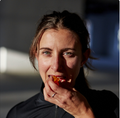
Amy Wolff is the photo director of Popular Mechanics, Bicycling, and Runner’s World, overseeing visual content for print and digital. Though her first love is the visual image, she’s a dedicated runner, loves the bike and as a new homeowner, learning new skills everyday.
